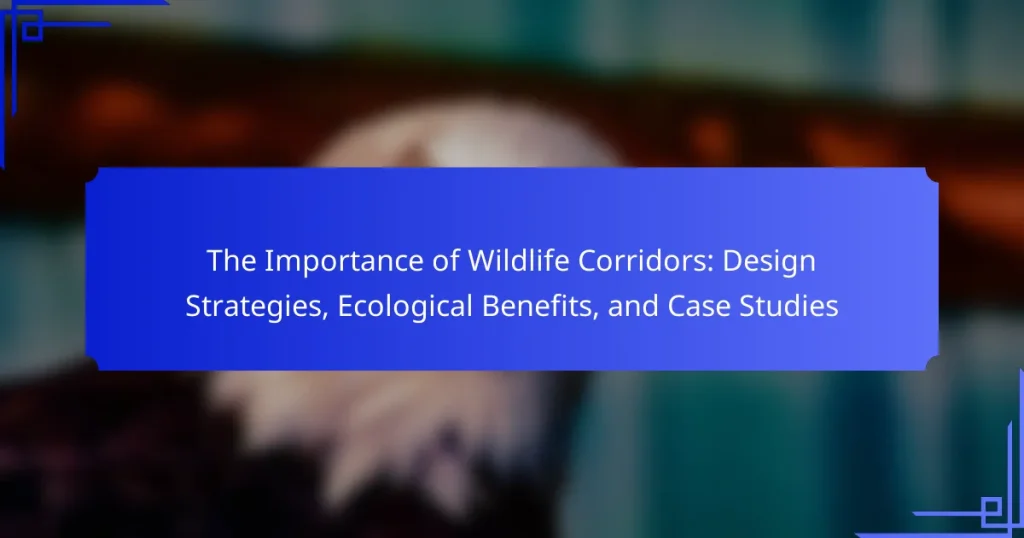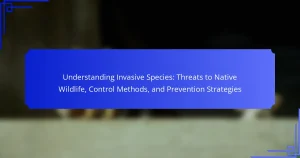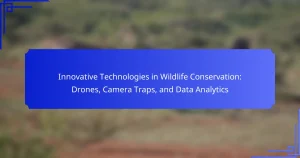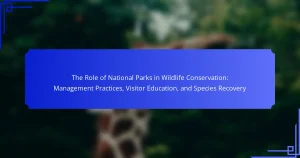
What are Wildlife Corridors and Why are They Important?
Wildlife corridors are designated areas that connect fragmented habitats. They allow animals to move safely between different ecosystems. This movement is crucial for genetic diversity and population stability. Corridors help mitigate the effects of habitat loss due to urbanization and agriculture. Studies show that wildlife corridors improve species survival rates. For example, a study by Beier and Noss (1998) emphasizes their role in maintaining biodiversity. Additionally, corridors can reduce roadkill incidents by providing safe passage for wildlife. Overall, wildlife corridors are essential for conserving ecosystems and supporting wildlife populations.
How do Wildlife Corridors function in ecosystems?
Wildlife corridors function as pathways that connect fragmented habitats. They allow animals to move between these habitats, promoting genetic diversity. This movement reduces the risks of inbreeding among isolated populations. Corridors also facilitate access to resources like food and water. They help species adapt to changes in their environment. Studies show that corridors can increase species richness in ecosystems. For example, the Yellowstone to Yukon Conservation Initiative demonstrates successful wildlife movement across vast landscapes. Such initiatives highlight the critical role of corridors in maintaining ecosystem health.
What are the key elements that make up a Wildlife Corridor?
Wildlife corridors consist of several key elements. These elements include habitat connectivity, which allows animals to move between different ecosystems. They also feature natural landscapes that provide food and shelter for wildlife. Additionally, wildlife corridors must be wide enough to accommodate various species and their movement patterns. The presence of minimal human disturbance is crucial for the success of these corridors. Furthermore, the corridors should connect to existing protected areas to enhance biodiversity. Research indicates that effective wildlife corridors can significantly reduce roadkill incidents and promote genetic diversity among animal populations.
How do Wildlife Corridors facilitate animal movement?
Wildlife corridors facilitate animal movement by providing safe passageways between fragmented habitats. These corridors connect isolated populations, allowing for genetic exchange and reducing inbreeding. They help animals avoid roadways and urban areas, minimizing vehicle collisions. Research shows that wildlife corridors can increase species diversity in connected habitats. For example, a study in the Journal of Applied Ecology found that corridors improved the movement of deer and other species by 30%. Additionally, corridors support migration patterns, essential for seasonal changes in food availability. By maintaining connectivity, wildlife corridors enhance ecosystem resilience and stability.
What ecological benefits do Wildlife Corridors provide?
Wildlife corridors provide critical ecological benefits by facilitating animal movement and genetic exchange. They connect fragmented habitats, allowing species to migrate safely between areas. This connectivity helps maintain biodiversity by supporting larger populations. Increased genetic diversity enhances species resilience to disease and environmental changes. Wildlife corridors also reduce roadkill incidents by directing animal movement away from roads. They promote ecosystem health by enabling species to access resources like food and water. Studies indicate that corridors can increase species richness in fragmented landscapes. Overall, wildlife corridors play a vital role in preserving ecosystems and supporting wildlife populations.
How do Wildlife Corridors contribute to biodiversity?
Wildlife corridors enhance biodiversity by connecting fragmented habitats. These passages allow animals to migrate, find food, and reproduce. Increased genetic diversity occurs when populations interbreed. This interbreeding strengthens species resilience to diseases and environmental changes. Studies show that wildlife corridors reduce roadkill incidents, promoting safer animal movement. For example, the Banff Wildlife Crossings in Canada decreased elk mortality by 80%. Additionally, corridors support ecosystem services such as pollination and seed dispersal. They also facilitate the movement of various species, maintaining ecological balance. Overall, wildlife corridors are crucial for sustaining diverse ecosystems.
What role do Wildlife Corridors play in habitat connectivity?
Wildlife corridors facilitate habitat connectivity by linking fragmented ecosystems. These pathways allow animals to move between habitats, enhancing genetic diversity. Increased genetic diversity strengthens populations and improves resilience to environmental changes. Corridors also reduce roadkill by providing safe passage across human-made barriers. Studies show that wildlife corridors can significantly increase species movement and survival rates. For instance, a study in the Yellowstone to Yukon corridor demonstrated improved connectivity for multiple species. This connectivity is critical for maintaining healthy ecosystems and biodiversity.

What Design Strategies are Effective for Wildlife Corridors?
Effective design strategies for wildlife corridors include creating natural landscape connections, using overpasses and underpasses, and incorporating native vegetation. Natural landscape connections facilitate animal movement between habitats. Overpasses and underpasses reduce vehicle collisions and promote safe crossings. Incorporating native vegetation supports local wildlife by providing food and shelter. These strategies enhance ecological connectivity and biodiversity. Research shows that well-designed corridors increase species diversity and population viability. For example, studies in the U.S. demonstrate that wildlife crossings significantly reduce roadkill and improve animal movement patterns.
How can landscape features influence Wildlife Corridor design?
Landscape features significantly influence Wildlife Corridor design. Natural elements such as rivers, mountains, and vegetation patterns dictate the placement and structure of corridors. For instance, rivers can serve as natural barriers or pathways, guiding wildlife movement. Mountain ranges may restrict animal movement, necessitating elevated corridors. Vegetation types affect habitat availability and species diversity within corridors. Corridors must align with existing landscape features to enhance connectivity. Research indicates that well-designed corridors increase species migration and genetic diversity. A study by Beier and Noss (1998) highlights the importance of considering landscape features in corridor planning for effective wildlife conservation.
What types of vegetation are best suited for Wildlife Corridors?
Native vegetation types are best suited for wildlife corridors. These include shrubs, grasses, and trees that are indigenous to the region. Native plants provide essential food and habitat for local wildlife. They support biodiversity by attracting various species. Additionally, native vegetation helps maintain ecological balance. It offers cover and travel paths for animals. Studies show that wildlife corridors with native plants enhance species movement. This promotes genetic diversity and population stability.
How do human-made structures affect the design of Wildlife Corridors?
Human-made structures significantly influence the design of wildlife corridors. These structures include roads, buildings, and fences, which can obstruct animal movement. Wildlife corridors must be strategically placed to mitigate these barriers. Design considerations include the width, height, and location of corridors. Corridors need to connect habitats effectively while avoiding human interference. Studies show that properly designed corridors can enhance species movement and genetic diversity. For example, the I-90 Wildlife Watch project in Washington State successfully integrated overpasses and underpasses for wildlife. These design strategies demonstrate how human-made structures can be adapted to support wildlife conservation efforts.
What are the best practices for implementing Wildlife Corridor designs?
Best practices for implementing Wildlife Corridor designs include conducting thorough ecological assessments. These assessments identify critical habitats and species movement patterns. Collaboration with local stakeholders is essential for successful design and implementation. Engaging communities fosters support and awareness for wildlife corridors.
Integrating corridors into existing landscapes enhances connectivity. This can be achieved by utilizing natural features such as rivers and ridges. Designing corridors with diverse vegetation promotes habitat quality. Research shows that diverse plant life supports various wildlife species.
Regular monitoring and adaptive management are crucial for long-term success. This involves tracking wildlife usage and corridor effectiveness. Adjustments may be necessary based on monitoring data. Studies indicate that well-maintained corridors significantly improve wildlife populations.
How can community involvement enhance Wildlife Corridor projects?
Community involvement can significantly enhance Wildlife Corridor projects. Engaged communities contribute local knowledge about wildlife patterns. This insight aids in designing effective corridors that meet ecological needs. Community members often help identify critical habitat areas. Their participation can also boost funding through local fundraising efforts. Additionally, community involvement fosters stewardship and advocacy for wildlife conservation. Studies show that projects with community engagement have higher success rates. For example, the “Connecting Habitat Across Borders” initiative highlighted the importance of local participation in corridor success.
What technologies assist in the design and monitoring of Wildlife Corridors?
Geographic Information Systems (GIS) assist in the design and monitoring of wildlife corridors. GIS technology allows for the mapping of habitats and landscapes. It helps identify critical areas for wildlife movement. Remote sensing technologies, such as satellite imagery, provide data on land use changes. These changes impact wildlife connectivity. Camera traps are used to monitor wildlife presence in corridors. They offer real-time data on animal movements. Acoustic sensors can track vocalizations of species in these areas. Drones are utilized for aerial surveys of potential corridor sites. These technologies enhance our understanding of wildlife behavior and habitat needs.

What are Some Successful Case Studies of Wildlife Corridors?
Successful case studies of wildlife corridors include the Banff Wildlife Crossings in Canada. This project features over 30 wildlife overpasses and underpasses. It has significantly reduced wildlife-vehicle collisions. Research indicates a 80% reduction in such incidents since its implementation. Another example is the Florida Wildlife Corridor. This corridor connects over 18 million acres of protected land. It facilitates safe animal movement between ecosystems. Studies show increased biodiversity and healthier wildlife populations in the area. The I-90 Wildlife Watch in Washington State also exemplifies success. This initiative includes wildlife bridges and fencing. It has improved the safe passage of species like deer and elk. These case studies demonstrate the effectiveness of wildlife corridors in enhancing connectivity and safety for wildlife.
How have Wildlife Corridors been successfully implemented in various regions?
Wildlife corridors have been successfully implemented in various regions through strategic planning and community involvement. In the United States, the Yellowstone to Yukon Conservation Initiative connects habitats across multiple states. This corridor enhances genetic diversity among species and reduces roadkill incidents. In Australia, the Great Eastern Ranges Initiative links protected areas along the eastern coast. This project supports climate adaptation for wildlife. In Europe, the European Green Belt creates a network of protected areas that facilitates animal movement across borders. These implementations demonstrate the effectiveness of wildlife corridors in preserving biodiversity and promoting ecological resilience.
What lessons can be learned from successful Wildlife Corridor projects?
Successful Wildlife Corridor projects demonstrate the importance of stakeholder collaboration. Engaging local communities, governments, and conservation organizations is crucial. Effective communication fosters shared goals and resources. Additionally, adaptive management strategies are essential. Monitoring ecological outcomes allows for timely adjustments. Successful corridors often incorporate diverse habitats. This diversity supports various species and ecological processes. Finally, public awareness and education enhance project sustainability. Informed communities are more likely to support conservation efforts. These lessons underscore the multifaceted approach needed for effective wildlife corridors.
How do these case studies demonstrate the effectiveness of Wildlife Corridors?
Case studies demonstrate the effectiveness of wildlife corridors by providing empirical evidence of increased animal movement and biodiversity. For instance, the Banff Wildlife Crossings project in Canada increased the safe passage of mammals by 80% after the installation of overpasses and underpasses. Similarly, the Florida Wildlife Corridor has shown a rise in the population of key species, such as the Florida panther, due to enhanced connectivity. These corridors reduce roadkill incidents, as evidenced by a 50% decrease in wildlife-vehicle collisions in specific areas after corridor implementation. Additionally, studies in the Netherlands revealed that wildlife corridors improved genetic diversity among fragmented populations, indicating successful long-term conservation outcomes. Such findings underscore the crucial role of wildlife corridors in mitigating habitat fragmentation and promoting ecological resilience.
What challenges do Wildlife Corridor projects typically face?
Wildlife Corridor projects typically face issues such as habitat fragmentation, land use conflicts, and funding limitations. Habitat fragmentation disrupts animal movement and reduces genetic diversity. Land use conflicts arise when corridors intersect with developed areas or agricultural land. This can lead to resistance from landowners and stakeholders. Funding limitations often hinder the planning and construction of these projects. Many corridors require significant financial investment for land acquisition and maintenance. Additionally, climate change poses challenges by altering species distribution and habitat conditions. These factors collectively complicate the successful implementation of Wildlife Corridor projects.
What strategies can be employed to overcome obstacles in Wildlife Corridor implementation?
To overcome obstacles in Wildlife Corridor implementation, stakeholders can employ several strategies. Collaboration among government agencies, NGOs, and local communities is crucial. This collaboration fosters shared goals and resources. Engaging stakeholders early in the planning process enhances support and reduces resistance. Utilizing scientific data to demonstrate ecological benefits can strengthen arguments for corridors. Public awareness campaigns can educate communities on the importance of wildlife corridors. Securing funding through grants and partnerships is essential for project sustainability. Adaptive management practices allow for ongoing assessment and adjustments as needed. Successful case studies can serve as models to inspire similar projects elsewhere.
What practical tips can be applied when planning Wildlife Corridors?
Identify key wildlife species that require connectivity. Assess their movement patterns and habitat needs. Involve local stakeholders in the planning process. Conduct ecological assessments to determine suitable corridor locations. Design corridors with appropriate width to facilitate safe passage. Incorporate vegetation that supports local wildlife. Utilize existing natural features to enhance corridor effectiveness. Monitor and adapt corridor designs based on wildlife usage data.
Wildlife corridors are critical pathways that connect fragmented habitats, facilitating safe animal movement and promoting genetic diversity. This article explores the design strategies for effective wildlife corridors, their ecological benefits, and successful case studies demonstrating their impact on biodiversity and species survival. Key elements such as habitat connectivity, vegetation types, and community involvement are discussed, alongside challenges faced in implementation and strategies to overcome them. The article emphasizes the importance of wildlife corridors in conserving ecosystems and supporting wildlife populations.




